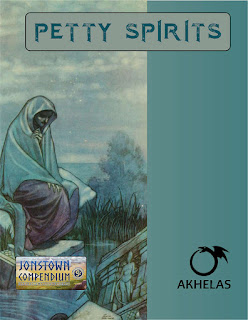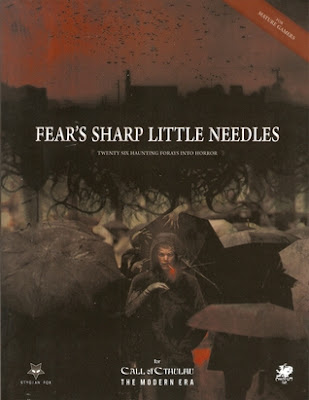 Fear’s Sharp Little Needles: Twenty-Six Hunting Forays into Horror
Fear’s Sharp Little Needles: Twenty-Six Hunting Forays into Horror is an anthology of scenarios published by
Stygian Fox for use with
Call of Cthulhu, Seventh Edition. Published following a successful
Kickstarterter campaign, it follows on from the highly-regarded
Things We Leave Behind in being set in the modern day, in dealing with mature themes, and in containing contributions from a number of tried-and-tested scenario authors from the last decade or so. What sets it apart though, is that
Fear’s Sharp Little Needles contains some twenty-six scenarios, all but one of them, short, sharp stabs of horror—typically each five or six pages in length and thus the length of a magazine scenario or so. All twenty-six can work as one-shots, all but the last can work as convention scenarios, and all but the last require minimum preparation—the latter feature making
Fear’s Sharp Little Needles a useful anthology for the Keeper to pull off the shelf at the last minute and have something ready for her gaming group with relatively little effort. In many cases, the scenarios would also work with just the one player and Investigator and the one Keeper. However, with a little more effort, many of the scenarios in the campaign would also work in an ongoing campaign, and in fact, some of them would work with Arc Dream Publishing’s
Delta Green: The Role-Playing Game and some of them are actually linked together.
The design and the shortness of the scenarios in
Fear’s Sharp Little Needles means that none of them are lengthy, sophisticated, or convoluted pieces of investigation. They are direct, straightforward pieces of horror—in other words, ‘sharp, little needles’, each with a quick set-up, a relatively easy mystery to investigate and explain, and a solution. Each follows the same format. This starts with a one-page, full colour illustration as a frontispiece, and an introduction followed by a guide to ‘Involving the Investigators’ and ending with ‘Rewards and Repercussions’. In between which is the scenario itself. The frontispiece includes the scenario’s title, author, and four tags for the scenario’s four elements. So, for Brian Courtemanche’s ‘Do Not Call Up That Which You Cannot Put Down’, these are ‘Sea Monster’, ‘Summoning’, ‘Cover-Up’, and ‘Martin’s Beach’. The ‘Rewards and Repercussions’ covers the possible Sanity rewards and losses for a successful or unsuccessful conclusion of the scenario respectively as well as any consequences. This section is also where the monster and NPC stats are listed. Lastly, some scenarios contain an extra box marked ‘Track Marks’, not only keeping in theme with the anthology’s title, but also making connections between some of the scenarios in
Fear’s Sharp Little Needles. Not every scenario has a ‘Track Marks’ section, and even those that do can still be run as standalone scenarios rather than being linked in some way.
The anthology opens with the first of two scenarios by Jeffrey Moeller. ‘Separation Anxiety’ concerns a missing biomedical researcher whose investigation into her own condition lead to her being covertly investigated herself and then her disappearance. In tracking her down, the investigators will end up in the hometown of a creepy family in what is nicely traditional style
Call of Cthulhu scenario to start the collection with.
Simon Brake’s ‘Undertow’ is more underplayed in its horror in comparison to the other scenarios in the anthology. A new horror novel from Justin Hayes after a gap of a few years has hit the bestseller lists, but its dark tale of a Los Angeles-based actress whose downward spiral into despair appears to be influenced by the Cthulhu Mythos. The question is, just how much does the novelist know about the Mythos? What exactly is going on feels slightly oblique, but the relative lack of lethality means that it would nicely work as a single-Investigator scenario.
Oscar Rios contributes three scenarios to
Fear’s Sharp Little Needles. The first is ‘Sins Of My Youth’, in which a seemingly inexplicable attack by a homeless person swathed in manky clothing quickly escalates into something much more personal. Inspired by
The Terminator franchise, this is a nasty confrontational set-up which best works when played out as a series of interludes. Oscar Rios’ second scenario, ‘Poetry Night’ takes place at a poetry event at The Lakeside, a coffee shop which sits on Juniper Lake in the Pine County Artist Enclave. What should be a relaxing evening takes a nasty turn as a bad ode draws the attendees to the shores of another lake. Veteran devotees of
Call of Cthulhu will recognise familiar elements in the scenario, but the brevity of the format means that the author pleasingly filters these elements down to an espresso rather than perhaps a latte. Oscar Rios’ third scenario, is the penultimate scenario in
Fear’s Sharp Little Needles. ‘The Winoka Point Research Center’ is really a location-based scenario, being primarily set on an island that is the subject of several urban legends. It is said that it was once home to a government research facility, but this is utterly disavowed and seemingly wiped from history—and as the Investigators get closer to the island, actually increasingly difficult to get ashore. Of course, there is certainly more than a grain of truth to the urban legends and there are some nasty surprises to be found in the Winoka Point Research Center. The issue here really, is player or Investigator motivation, so using this scenario in an ongoing campaign is likely to be challenging.
In ‘Walter’s Final Wish’, the Investigators are either visitors, employees, or residents at the Whispering Willow Retirement Home when everything goes to hell. Initially, Matt Wiseman and Jennifer Thrasher’s scenario has a traditional horror set-up—a zombie outbreak—which gives a fun, familiar feel until it delivers a nasty twist to the ‘Investigators’. Jason Williams’ ‘Whose Fuel Is Men And Stones’ is specifically written to be played by one Investigator and one Keeper and takes that Investigator on holiday to London as the result of an inheritance. The holiday takes an increasingly odd, even weird turn, and then has a nasty twist. This though is balanced against an opportunity for some solid roleplaying interaction between player and Keeper, and so will require fairly careful roleplaying upon the part of the Keeper to work effectively.
Matthew Sanderson contributes two scenarios to
Fear’s Sharp Little Needles. The first, ‘Pulvis Et Umbra Sumus’ brings together several Investigators from across the USA to rural Maine. Each is from a large city, each is relatively poor and in debt, but all learn that they are the beneficiaries of a will. Of course, being the beneficiary of a will is never a good thing in Call of Cthulhu and such is the case in this scenario, which places innocents in a terrible situation and forces them to deal with it. In the second scenario, ‘Dissociation’, has the Investigators all aboard a night flight up the USA’s Pacific coast when the aeroplane is cut up, the passengers are sucked out into the open sky, and- This has the Investigators running around like rats in a maze and whilst both scenarios essentially cast the Investigators as victims, ‘Dissociation’ is the more interesting of the two, and definitely has the more powerful opening scene.
‘The Great And Terrible Awto’ by Jo Kreil, begins with a ‘hit and run’ and the victim begging for help. It turns out that he is a scientist working on a revolutionary new automobile engine, but who would want to kill him? The truth is as always, both weird and horrifying and the Investigators will need to rush in order to prevent one hell of a car crash.
‘Spilsbury #9485’ is the first of two scenarios by Adam Gauntlett. It takes its set-up from the idea of the disposing of bodies in large pieces of luggage and then turns that luggage—in this case, a well-travelled steamer trunk which certainly got as far as Istanbul—into an artifact which keeps appearing over and over to spread chaos, horror, and death. Unfortunately, the Investigators are just at the railway station when this happens once again… The Spilsbury of the title refers to the noted pathologist, Sir Bernard Spilsbury, and also in the scenario to the Spilsburys, a group dedicated to keeping track of the steamer trunk. The Spilsburys would certainly work as an Investigator group with some development. The scenario also affords the Keeper—or Handler—the opportunity to bring PISCES from the
Delta Green: The Role-Playing Game into play, has some entertaining nods to
Call of Cthulhu scenarios past, and in general, this has nicely done echoes of Nigel Kneale’s work (or even the television series,
Sapphire & Steel). Adam Gauntlett’s second scenario is co-written with Brian M. Sammons, and is a much bloodier, nastier affair. ‘The Special Menu’ would also work well with the
Delta Green: The Role-Playing Game as various investigators and agencies are called into to investigate an incident at a Wyse Fries fast food outlet where an employee and a customer have been found dead from having ingested rat poison.
Joe Trier’s ‘Lights Out’ begins as a simple missing persons case—a teenager, depressed after the death of her boyfriend, has disappeared. However, it quickly escalates into murder and arson, and presents the Investiagtors with a potentially difficult dilemma. This scenario moves smartly along and feels not unlike a horror film. Strange murders and missing body parts spur the investigation in Alan Goodall’s ‘Bone Deep’, which again would work with the
Delta Green: The Role-Playing Game. A weird medical condition and a winding down funeral home are nicely tied together by new lore for the ghoulish antagonists. In comparison to the previous ‘Lights Out’, this has more of a televisual feel.
However, ‘Do Not Call Up That Which You Cannot Put Down’ has again a filmic tone—in particular,
Jaws. Brian Courtemanche’s scenario is the first of two in the anthology to be set at sea and is set aboard a boat whose crew is taking part in the Massachusetts State Fisheries Department’s annual shark-tagging programme. The crew—or Investigators—have already had an encounter ashore with a drunk rambling about sea monsters, and whilst they will probably have dismissed his ravings, events out at sea prove that they should have listened. Taking place aboard a small boat, it has a claustrophobic feel despite it being at sea and really delivers a horrible dilemma for the Investigators.
In Tyler Hudak’s ‘Hit And Run’, the Investigators witness the eponymous death on the road. That would seem to be that, but then the driver of the other car comes to them for help, telling them that following the incident, he is being hunted. This is a serviceable adventure which has potential as an on-the-road encounter between the larger parts of a campaign.
Andi Newton has two scenarios in
Fear’s Sharp Little Needles. The first is the other sea-based scenario in the anthology, ‘Remaking The Hatteras Reef’. This is set on the North Carolina coast where strangely mutated fish have recently begun to be caught and a diver has been badly injured in a fish attack. The North Carolina Wildlife Resource Commission believes that an old ship, recently scuttled to rebuild the reef, has leaked some sort of contaminants. Getting the Investigators directly involved may be difficult for a campaign, but with the right characters this has a nice sense of atmosphere and place, and sets up an interesting technical challenge.
The second scenario by Andi Newton is ‘The Tormiss Crd Model Z-17’. The Tormiss CRD Model Z-17 of the title is a successful model of pacemaker which has a perfect record. Now when one is removed from a cadaver at a mortuary, a strange discovery is made—the leads which connect to the heart are full of a clear, viscous fluid instead of the standard electrically conductive material, and then the fluid seems to wriggle… Now a video of the device has been put online and the Investigators are tasked with looking into both what happened and the strange device. Of course, the trail leads back to the manufacturer. This scenario would work well with
Delta Green: The Role-Playing Game, but however it is used, it makes nice use of a common medical device.
Most of the scenarios in
Fear’s Sharp Little Needles are set in the USA. Of course, many of them can be moved elsewhere, but ‘The Sores’ by Helen Gould is specifically set elsewhere. In the 1990s, a terrible illness swept the small town of Dirgel, Wales, causing weeping sores and, eventually, death. Now, it has returned. Whether as medical personnel, police detectives, or even local residents in the now quarantined town, the investigators must race to find out the cause even as they break out in sores… This is weird and creepy, though the Keeper may want to do a little research on what Welsh towns are like as part of her scenario preparation.
Chad Bowser’s ‘Up Jumped The Reaper’ is another case of a missing person. This time a promising graduate student pursuing a degree in American Folklore. Her research has taken her into the Western North Carolina Mountains and her family is growing concerned about the whereabouts of both her and her boyfriend. Essentially, this is a decent rural bogeyman horror tale. In the earlier ‘Sins Of My Youth’, only the one Investigator is the target, but in Stuart Boon’s ‘Resurrection’, all of the Investigators become the targets. The scenario begins at the rain-sodden funeral of a college friend when they are confronted by someone who looks like another college friend who disappeared years ago and is thought to be dead. The question is, where has he been, and then, why is he targeting the Investigators? This scenario is simply okay.
‘Waiting To Be Born’ by Christopher Smith Adair is a one-location scenario, primarily being set in and around the New Life Fertility Center in the Canyon Lake, Texas area, fifty miles north of San Antonio. The clinic was set up to provide holistic solutions for infertile couples, but the Investigators are asked to look into it by a couple who blame their son’s death on the clinic. Alternative options are suggested, which give stronger reasons for the Investigators to be at the clinic, as perhaps this is not the strongest reason for them to investigate or get into the clinic. That said, when they do, there is a slightly odd feel to the clinic, which turns downright weird once they penetrate its depths. One potential angle or location feels slightly underdeveloped, but overall the scenario really works once the Investigators are inside the facility.
Scott Dorward’s ‘Unland’ takes place at former amusement park which was shut down two decades ago following a terrible scandal. The Investigators will need a good reason to visit the dilapidated site, but once inside find themselves trapped in a horrid funhouse, full of hellishly collapsed rides, mirrors, and strange remnants of former attendees. Ultimately the horror in ‘Unland’ will take a very personal turn for each of the Investigators and so may not be to the taste of every player. Nevertheless, short and creepy.
At just three pages, ‘The Focus Group’ by Simon Yee, is the shortest scenario in
Fear’s Sharp Little Needles at just three pages. Prior to the start of the scenario, the Investigators were brought together as a play test focus group for a geo-caching, puzzle-solving game called ‘The Cage of Morpheus’, but after a problem with the music, they are brought back in to test the new version. When their smartphones start displaying odd content and things start getting weird, is it the game or is it something else? This is a good scenario if the Keeper wanted to inflict pithecophobia on an Investigator, but it is a short scenario, probably too short to run as a convention scenario.
Glynn Owen Barras’ ‘Ghosts Of Ravenscar’ is another missing persons case, this time in England, at an abandoned village, just south of Whitby, on the Yorkshire coast. The investigators find themselves stalked amongst the ruins and must deal with the monsters if they are to escape. Coming towards the end of the anthology, this suffers from being too similar to earlier adventures and reliant upon a similar set-up. So again, it is okay.
Rounding out
Fear’s Sharp Little Needles is ‘Phlebotomy’, Jeffery Moeller’s second contribution to the anthology. Unlike the previous twenty-five scenarios in the book, this is a full length scenario, one which will take multiple sessions to complete. It begins in nasty fashion at the QwikLab Phlebotomy Clinic in Cleveland, Ohio when on an ordinary morning, a patient suddenly begins screaming in rage and pain, before driving a syringe through the eye of a nurse and into her brain, thus killing her. He then explodes into a puddle of goop. This set-up leads into a lengthy and convoluted investigation, perhaps linked to a mysterious patient who was also at the clinic that morning. The problem with the scenario is the difference between the set-up and the investigation. The set-up really works well with one or more of the Investigators at the clinic and the investigation really works with the Investigators as law enforcement or Delta Green agents. However, having the Investigators as the law enforcement or Delta Green agents means that they are unlikely to experience the set-up, and having the Investigators at the set-up makes it harder for them to be law enforcement or Delta Green agents, and so the investigation is going to be a whole lot more challenging. Find a way to balance the issue and this is still a good investigative scenario, throwing the Investigators into a modern celebrity culture, a conspiracy of sorts, and potentially, to a link back to the first scenario in the book, ‘Separation Anxiety’. In fact, the two work well together and perhaps it would have been interesting to see the two pulled out of the anthology and perhaps developed with another scenario or two as a mini-campaign. Ultimately, this scenario is not as good as the author’s ‘Ladybug, Ladybug, Fly Away Home’ from
Things We Leave Behind, but it is still a very good, well detailed scenario. The nod to the superb
Nameless Cults Volume One: Lost in the Lights – A Call of Cthulhu sourcebook of cult horror in the handouts is a nice touch.
Physically,
Fear’s Sharp Little Needles is very well presented, the layout being pleasingly uncluttered and easy to read. Reuben Dodd’s colour artwork is excellent, the layout is clean, the maps are clear, and the writing is good. Plus all of the handouts, all of them done in full colour, are repeated at the end of the book.
Whether they are looking for a one-shot, a convention scenario, or something short to add to a campaign, then
Fear’s Sharp Little Needles has about everything a Keeper would want. Though some of them will need some development in terms of set-up for a campaign or even just preparation of pre-generated Investigators, there is not a bad scenario amongst the twenty-six entries in the anthology, and some of them are excellent pieces of horror. Each one of the short scenarios in this anthology is clearly presented, easy to understand, and easy to prepare, enabling the Keeper to deliver each one of
Fear’s Sharp Little Needles: Twenty-Six Hunting Forays into Horror with the horror they deserve.








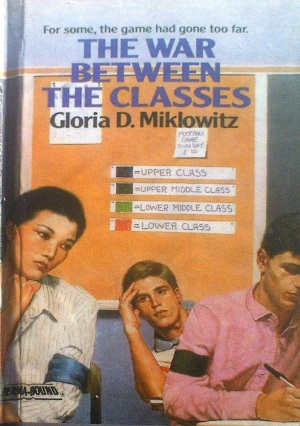







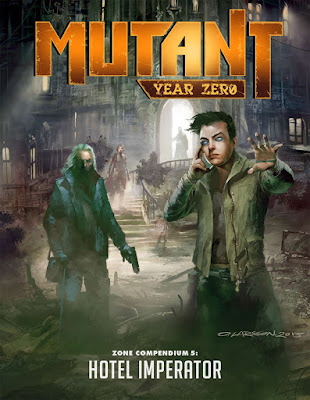


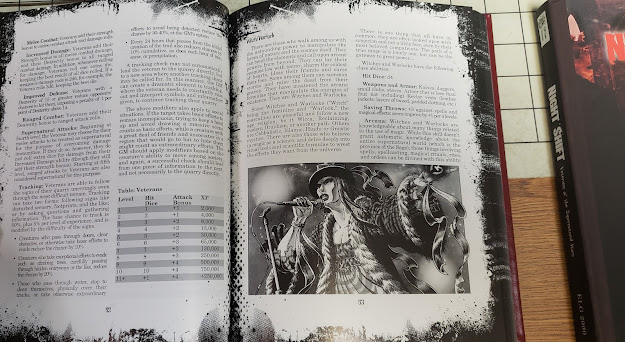



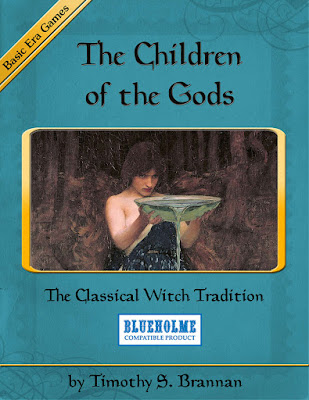


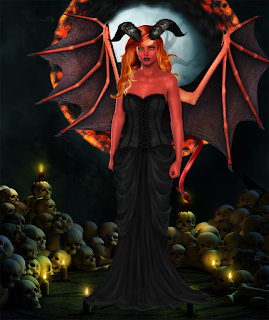

 Bring That Beat Back: How Sampling Built Hip-Hop
Bring That Beat Back: How Sampling Built Hip-Hop






 It is an undeniable truth that the Witch gets a lot of bad press. Not necessarily within the roleplaying hobby, but from without, for the Witch is seen as a figure of evil, often—though not necessarily—a female figure of evil, and a figure to be feared and persecuted. Much of this stems from the historical witch-hunts of the fifteenth, sixteenth, seventeen, and eighteenth centuries, along with the associated imagery, that is, the crone with the broom, pointy hat, black cat, cauldron, and more. When a Witch does appear in roleplaying, whether it is a historical or a fantasy setting, it is typically as the villain, as the perpetrator of some vile crime or mystery for the player characters to solve and stop. Publisher
It is an undeniable truth that the Witch gets a lot of bad press. Not necessarily within the roleplaying hobby, but from without, for the Witch is seen as a figure of evil, often—though not necessarily—a female figure of evil, and a figure to be feared and persecuted. Much of this stems from the historical witch-hunts of the fifteenth, sixteenth, seventeen, and eighteenth centuries, along with the associated imagery, that is, the crone with the broom, pointy hat, black cat, cauldron, and more. When a Witch does appear in roleplaying, whether it is a historical or a fantasy setting, it is typically as the villain, as the perpetrator of some vile crime or mystery for the player characters to solve and stop. Publisher 